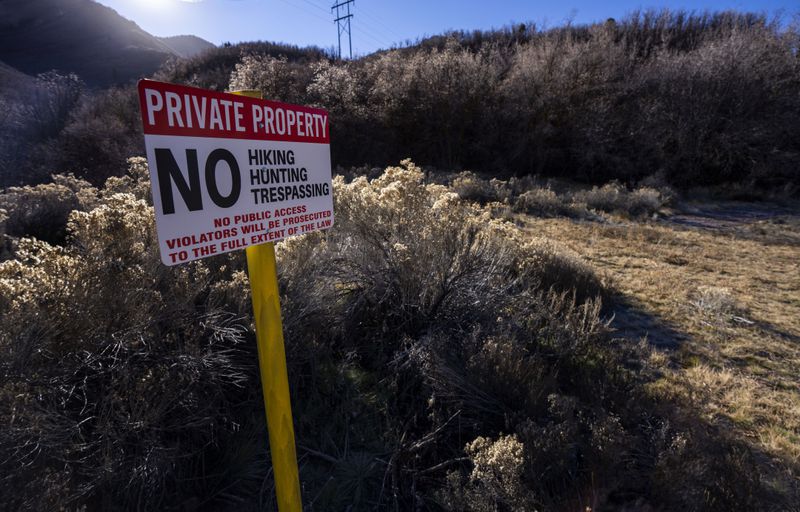Parleys Canyon mine proponents retrench behind a smaller project
Brian Maffly
Editor’s note • This story is available to Salt Lake Tribune subscribers only. Thank you for supporting local journalism.
In light of a controversial limestone quarry proposed in the foothills just outside Utah’s most populated area, state mining regulators are seeking to tighten procedures for approving mining operations in urban counties.
The problem, according to Utah Division of Oil, Gas and Mining Director John Baza, is the rules are tailored for rural areas, where the majority of Utah’s mining occurs. The growing demand for aggregate — sand, gravel, crushed stone and limestone needed for construction — is increasing pressure to open new quarries and expand existing ones.
“The second factor is the proximity of this urban growth to where these extraction activities can economically occur,” Baza told the Board of Oil, Gas and Mining on Wednesday. “Its physical proximity creates conflicts where there is urban, residential and even industrial interface with any number of other values such as view shed, airshed, open space, recreational areas, cultural-historic resources or wildlife habitat, to name a few.”
This is obvious in the battle over the quarry where Tree Farm LLC wants to extract and crush 2 million tons of limestone a year in Parleys Canyon.
With Utah’s population expected to grow by 66% over the next 40 years, DOGM expects to field more and more applications to approve extractive industries along the Wasatch Front. So Baza asked the board to open a rule-making process to create stricter permitting rules for mines in counties of the first and second classes. These are counties whose populations exceed 1 million and 125,000 respectively, a group that includes Cache, Weber, Davis, Salt Lake, Utah and Washington.
The proposal came before the board Wednesday when it convened to consider a procedural issue with the massive pit, dubbed I-80 South Quarry, proposed just a few miles up Interstate 15 from Salt Lake City. Tree Farm wanted DOGM to reconsider its rejected application to dig a small mine, defined as one that does not exceed 20 acres. The company also filed an application for a large mine that would cover much of its 634-acre property under Grandeur Peak.
To resolve its dispute with DOGM, Tree Farm agreed to withdraw its large-mine application to focus exclusively on a smaller operation. The small mine is certain to be strongly opposed by Salt Lake County, Salt Lake City, Millcreek and thousands of residents who don’t want to see any new mining in the central Wasatch.
“The public sentiment caught us off guard. This has been a more involved process than we were anticipating,” said Tree Farm’s lawyer Justin Matkin. “This is an attempt to allow us to move forward with small mine and taking the economic risk associated with it. From our point of view, the small mine is a self-sustainable viable operation in and of itself.”
The company, in the meantime, reserves the right to renew its application for a large mine at a later date.
“We understand the large mine would be a multiyear process to get approved with potential appeals and issues with the county given the public sentiment here,” Matkin said. “We are trying to operate under the rules to proceed with the economic plan we believe is viable and permitted while allowing the large mine application to proceed on its own course.”
As a small mine, the proposed quarry will undergo a much less rigorous review than if it exceeds 20 acres. Nor will its review require public participation.
A lawyer for the Richards Family Partnership, which owns much of the land abutting the proposed mine, said DOGM should still give the project a full review regardless of its size since Tree Farm has clearly signaled its intention to build and operate a massive mine for a long time.
“My concern is that we don’t allow this procedural mechanism to become a means of avoiding the serious issues and concerns that have been raised,” Evan Strassberg said. “We believe there is authority for the board and the division to concern itself with public health and safety, and that those concerns be addressed before mining operations are allowed to begin.”
Small or large, the proposed quarry will most likely run afoul of zoning changes under consideration by the Salt Lake County Council. Under a proposal championed by Mayor Jenny Wilson and other elected leaders, the council is considering banning any new mining operations in the Wasatch foothills, effectively blocking Tree Farm’s plans. It could vote on the measure as soon as April 5.
The mining board ultimately accepted Tree Farm’s offer to withdraw its large mine application, but it rejected DOGM’s request for “policy guidance” regarding mining in urban counties, concluding that such a discussion should happen independently of the Parleys Canyon proposal.
DOGM indicated it would renew the request under a separate docket because of the pressing need for a more rigorous process for mines near Utah’s larger cities. Attorney Haley Sousa said it may be appropriate to reduce the threshold for small mines to 10 acres in urban counties and 5 acres if they are within incorporated areas, as well as designate some areas unsuitable for mining. That already happens with coal mines.
She also indicated small mines in the urban counties should also require DOGM approval, full reclamation plans and public participation. Such changes would require legislative action.
“We are not too late to begin finding acceptable solutions to what we know will be future conflicts,” Baza said. “In the past, extraction activities have occurred far distant from population centers. That separation of distance will be coming less likely in the future. … The extraction industry deserves consistency of regulatory policy and the public needs the products and materials that come from mining activities.”

en
2022-03-26T12:00:01.1260000Z
2022-03-26T12:00:01.1260000Z
https://www.sltrib.com/news/environment/2022/03/26/parleys-canyon-mine/